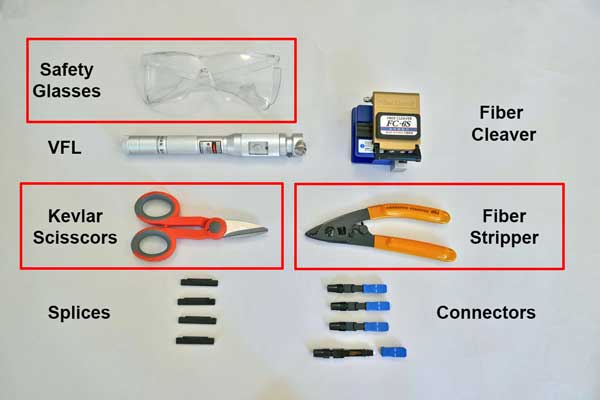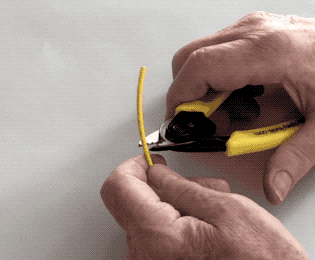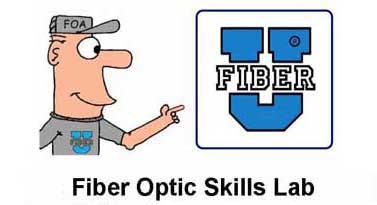Lesson:
Stripping Optical Fiber Cable
Objectives:
From this lesson you should learn:
How to use these tools to strip cable to the bare fiber
Tools:
Safety Glasses
Fiber Stripper
Kevlar Shears

Components:
Fiber optic cable

Safety:
 |
Always
wear safety glasses when doing any of
these exercises and dispose of all fiber
scraps properly.
Safety
Rules - Read before beginning any
exercises.
|
Exercise
1: Use kevlar scissors to cut the cable at the
middle.
We'll splice the two pieces back together in an
exercise and put new connectors on the bare ends in
another exercise.
2. Use the fiber stripper to cut off 2" (50mm) of the
cable jacket and pull off the cut piece.

Use the first groove in the fiber stripper - the
biggest one - and just gently cut the fiber jacket and
pull it off.
Be gentle so you do not damage the fiber. Note that some
strippers have only 2 grooves - one works for both 900
and 250micron buffer stripping.
3. Use the kevlar scissors to cut the aramid fibers at the
end of the jacket, exposing the 900micron tight buffered
fiber.
Wind the fibers into a bundle to make cutting them easier.
Cut close to the jacket end, exposing the fiber.
4. Use the fiber strippers to strip ~1" (25mm) from the
end of the fiber in 3 steps, about 1/4-3/8" (6-8mm) at a
time.
Hold the stripper at a 45degree angle to the fiber to
reduce stress on the fiber.
If your stripper has 3 grooves, use the second groove in
the stripper to remove the 900 micron buffer in 3 steps
then use the smallest groove to remove the 250 micron
buffer.
If
your stripper has 2 grooves, use the second groove in
the stripper to remove the fiber buffer in 3 steps. This
prevents putting excess stress on the fiber and prevents
breakage.
Don't be
discouraged if you break the fiber, this takes practice!
Make sure the stripper is held at the right angle. (It's
a right handed tool - left-handed people have trouble
getting the angle right and often use their right hand
to strip fiber with this stripper.)
Take small cuts - don't try to take off too much buffer
at once.
5.
Clean the fiber with a lint-free wipe and alcohol.
Special fiber optic cleaners are used in the field, but
for these exercises you can use regular alcohol and a
tissue or paper wipe or microfiber cloth used for
cleaning glasses.
Watch this to
see how it's done:

You
have successfully completed this exercise when you
have been able to strip the jacket and both buffer
coating layers from the fiber without breaking the
fiber.
Clean up all your fiber
scraps and dispose of them in a container like a used
take-out coffee cup marked "Fiber Scraps"!
After successfully stripping fiber several times, fill
in your Scorecard.
Return
to Lesson Plan
This information is
provided by The Fiber Optic Association, Inc. as a
benefit to those interested in teaching, designing,
manufacturing, selling, installing or using fiber optic
communications systems or networks. It is intended to be
used as an overview and/or basic guidelines and in no
way should be considered to be complete or
comprehensive. These guidelines are strictly the opinion
of the FOA and the reader is expected to use them as a
basis for learning, as a reference and for creating
their own documentation, project specifications, etc.
Those working with fiber optics in the classroom,
laboratory or field should follow all safety rules
carefully. The FOA assumes no liability for the use of
any of this material.
|

